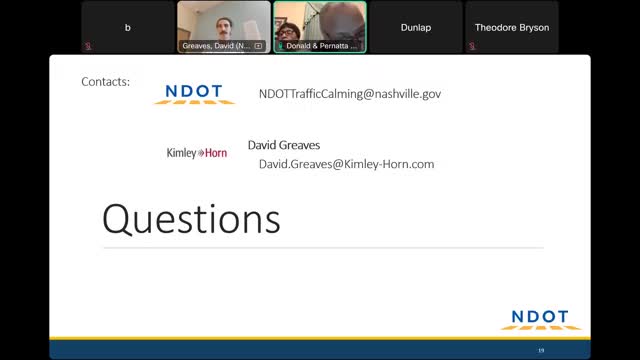Residents Voice Concerns Over Speed Cushions on Enchanted Circle Plan
July 26, 2025 | Nashville Department of Transportation (NDOT) Meetings, Nashville, Davidson County, Tennessee
This article was created by AI summarizing key points discussed. AI makes mistakes, so for full details and context, please refer to the video of the full meeting. Please report any errors so we can fix them. Report an error »

On July 21, 2025, residents of Enchanted Circle gathered for a traffic calming meeting hosted by the City of Nashville, focusing on safety measures along the neighborhood's roads. The discussions highlighted community concerns regarding speeding vehicles and the need for effective traffic management solutions.
A significant topic of conversation was the proposed placement of speed cushions along Enchanted Circle, specifically between Drake's Branch and King's Lane. Residents expressed frustration over the current traffic conditions, citing frequent speeding and accidents in the area. One resident noted that vehicles often exceed the speed limit, creating dangerous situations for families and children living nearby. The community's call for action was clear, as many voiced their experiences with reckless driving and the damage it has caused to property, including mailboxes.
City officials provided insights into the planning process, explaining that they had conducted measurements and assessments to determine the most effective locations for the speed cushions. However, some residents questioned the rationale behind the proposed limits for the project, suggesting that the design did not adequately address the steepness of the hill on Enchanted Circle, which could exacerbate traffic issues, especially in winter conditions.
The meeting also touched on the broader context of community safety, with residents advocating for additional measures such as sidewalks to protect pedestrians. Many expressed a desire for more comprehensive traffic solutions, arguing that speed cushions alone may not be sufficient to ensure safety.
As the meeting concluded, city officials reminded attendees that ballots for the proposed traffic calming measures would be sent out soon, encouraging community members to participate in the decision-making process. The discussions underscored the ongoing challenges faced by residents in Enchanted Circle and the importance of community engagement in shaping local traffic policies. The outcome of the ballot will likely determine the next steps in addressing these pressing safety concerns.
A significant topic of conversation was the proposed placement of speed cushions along Enchanted Circle, specifically between Drake's Branch and King's Lane. Residents expressed frustration over the current traffic conditions, citing frequent speeding and accidents in the area. One resident noted that vehicles often exceed the speed limit, creating dangerous situations for families and children living nearby. The community's call for action was clear, as many voiced their experiences with reckless driving and the damage it has caused to property, including mailboxes.
City officials provided insights into the planning process, explaining that they had conducted measurements and assessments to determine the most effective locations for the speed cushions. However, some residents questioned the rationale behind the proposed limits for the project, suggesting that the design did not adequately address the steepness of the hill on Enchanted Circle, which could exacerbate traffic issues, especially in winter conditions.
The meeting also touched on the broader context of community safety, with residents advocating for additional measures such as sidewalks to protect pedestrians. Many expressed a desire for more comprehensive traffic solutions, arguing that speed cushions alone may not be sufficient to ensure safety.
As the meeting concluded, city officials reminded attendees that ballots for the proposed traffic calming measures would be sent out soon, encouraging community members to participate in the decision-making process. The discussions underscored the ongoing challenges faced by residents in Enchanted Circle and the importance of community engagement in shaping local traffic policies. The outcome of the ballot will likely determine the next steps in addressing these pressing safety concerns.
View full meeting
This article is based on a recent meeting—watch the full video and explore the complete transcript for deeper insights into the discussion.
View full meeting
